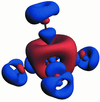issue contents
September 2014 issue

editorial
NEUTRON | SYNCHROTRON
The role of large-scale neutron and synchrotron facilities in the development of crystallographic research is discussed.
scientific commentaries
CHEMISTRY | CRYSTENG
Some questions are hard to address, and equally hard to ignore. Recent work by C. Y. Su et al. [Jiang et al. (2014), IUCrJ, 305–317] concerns a highly challenging aspect of crystalline coordination polymers – trying to understand how they form.
CHEMISTRY | CRYSTENG
The difficulties in defining the positions and thermal parameters for hydrogen atoms using X-ray diffraction data alone are discussed.
feature articles
NEUTRON | SYNCHROTRON
The use of synchrotron radiation for experimental electron-density determination during the last decade is reviewed. Possible future directions of this field are examined.
NEUTRON | SYNCHROTRON
Usually, semiconductors with a band gap Eg ≃ 3 eV or larger are called wide band gap materials. Their optical emission can span the whole of the visible spectrum, enabling the development of devices for solid-state lighting. In addition, a large Eg results in a high electrical breakthrough field, which is interesting for high-power electronics.
MATERIALS | COMPUTATION
Patterson-function direct methods are chronologically reviewed and their applications to powder and electron diffraction are described.
research papers
BIOLOGY | MEDICINE
Femtosecond X-ray crystallography allows structural analysis of a difficult-to-crystallize fusion protein that is a potential component of a candidate HIV-1 subunit vaccine.
CHEMISTRY | CRYSTENG
Download citation


Download citation


The co-crystallization of cyclic and polymeric isomers in the same crystal in varying ratios with the skeleton frameworks packed in a geometrically compatible and energetically similar fashion gives a chance to rationalize ring-opening isomerization in a crystal growth process.
CHEMISTRY | CRYSTENG
Download citation


Download citation


Relationships between the crystal structures of two polymorphs of sodium naproxen dihydrate and its monohydrate and anhydrate phases provide a basis to rationalize the observed transformation pathways in the sodium (S)-naproxen anhydrate–hydrate system.
BIOLOGY | MEDICINE
Two new structural forms, a monomer and a swapped dimer, of the catalytic domain of an adenylyl cyclase from M. tuberculosis are reported.
BIOLOGY | MEDICINE
An emulsion-based serial crystallographic technology has been developed, in which single crystals are grown in nanolitre-sized droplets inside an X-ray semi-transparent microfluidic chip exploiting a negative feedback mechanism. Diffraction data are measured, one crystal at a time, from a series of room-temperature crystals stored in the chip, and a 93% complete data set is obtained by merging single diffraction frames taken from different unoriented crystals to solve the structure of glucose isomerase to 2.1 Å.
CHEMISTRY | CRYSTENG
The new automated iterative Hirshfeld atom refinement method is explained and validated through comparison of structural models of Gly–L-Ala obtained from synchrotron X-ray and neutron diffraction data at 12, 50, 150 and 295 K. Structural parameters involving hydrogen atoms are determined with comparable precision from both experiments and agree mostly to within two combined standard uncertainties.



 journal menu
journal menu




 access
access























